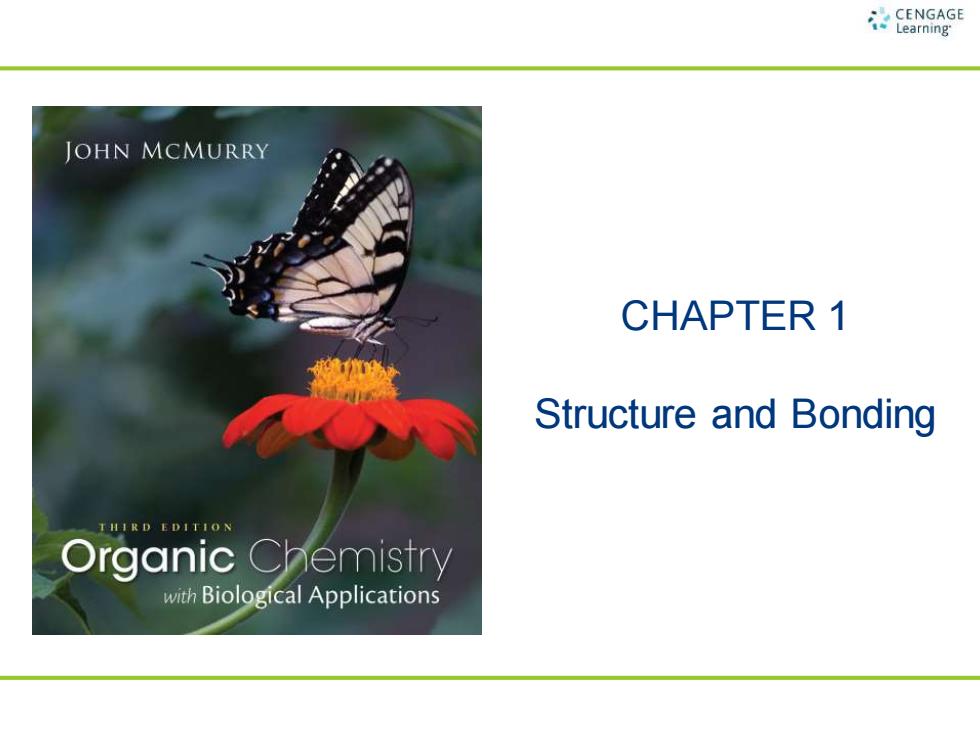
CNGNGE JOHN MCMURRY CHAPTER 1 Structure and Bonding EDITION Organic Chemistry with Biological Applications
CHAPTER 1 Structure and Bonding
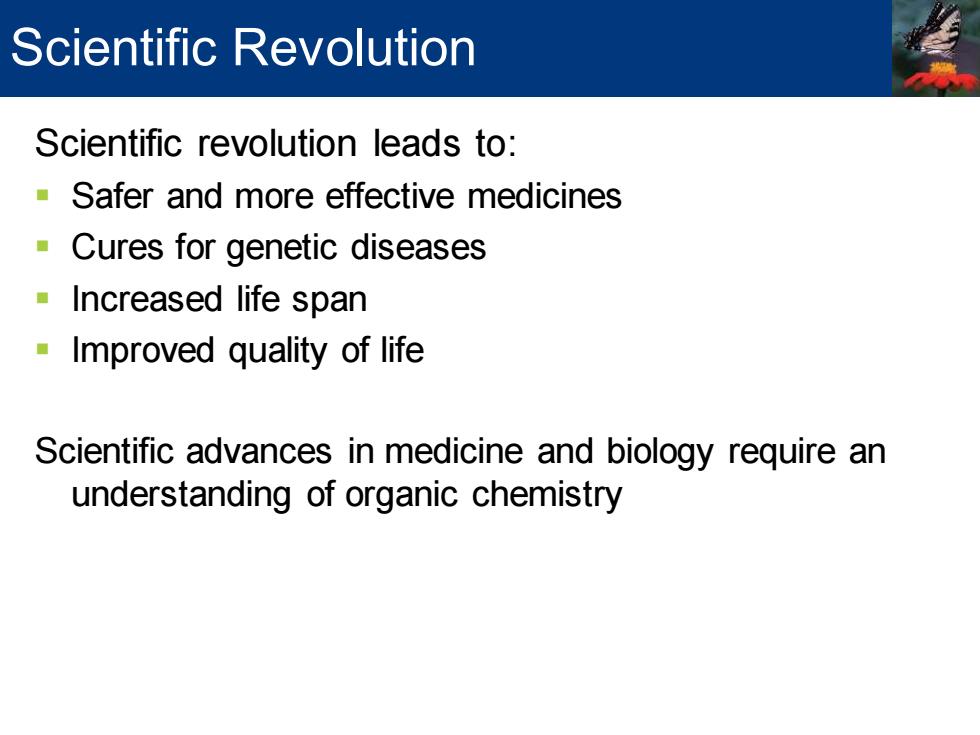
Scientific Revolution Scientific revolution leads to: Safer and more effective medicines Cures for genetic diseases ■Increased life span Improved quality of life Scientific advances in medicine and biology require an understanding of organic chemistry
Scientific revolution leads to: ▪ Safer and more effective medicines ▪ Cures for genetic diseases ▪ Increased life span ▪ Improved quality of life Scientific advances in medicine and biology require an understanding of organic chemistry Scientific Revolution
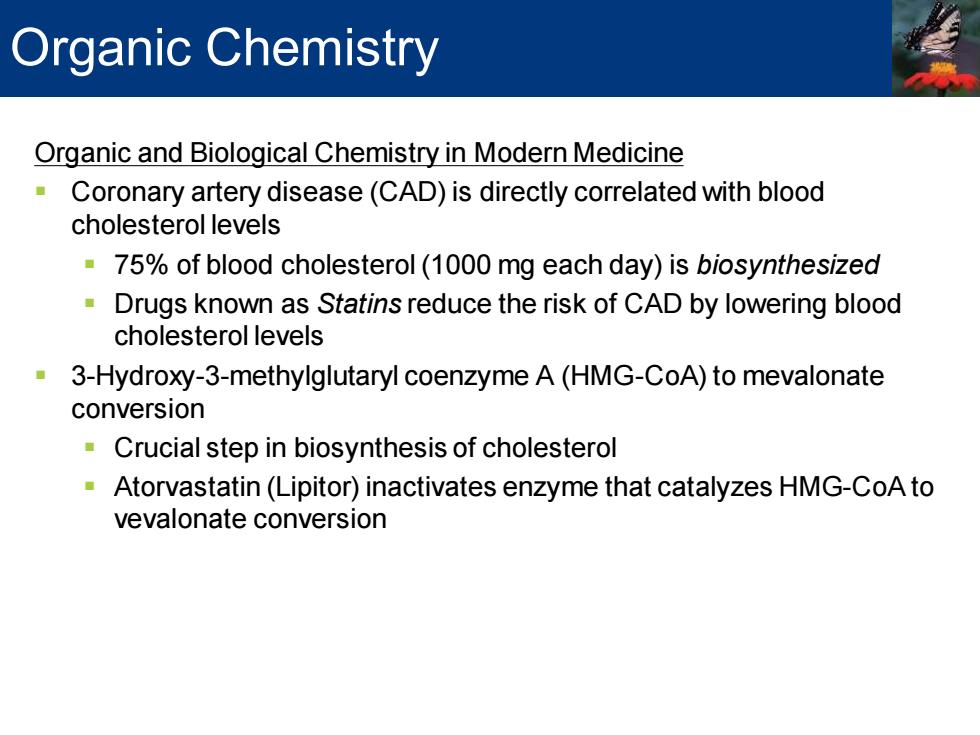
Organic Chemistry Organic and Biological Chemistry in Modern Medicine 。 Coronary artery disease(CAD)is directly correlated with blood cholesterol levels 75%of blood cholesterol (1000 mg each day)is biosynthesized Drugs known as Statins reduce the risk of CAD by lowering blood cholesterol levels 3-Hydroxy-3-methylglutaryl coenzyme A(HMG-CoA)to mevalonate conversion Crucial step in biosynthesis of cholesterol Atorvastatin(Lipitor)inactivates enzyme that catalyzes HMG-CoA to vevalonate conversion
Organic and Biological Chemistry in Modern Medicine ▪ Coronary artery disease (CAD) is directly correlated with blood cholesterol levels ▪ 75% of blood cholesterol (1000 mg each day) is biosynthesized ▪ Drugs known as Statins reduce the risk of CAD by lowering blood cholesterol levels ▪ 3-Hydroxy-3-methylglutaryl coenzyme A (HMG-CoA) to mevalonate conversion ▪ Crucial step in biosynthesis of cholesterol ▪ Atorvastatin (Lipitor) inactivates enzyme that catalyzes HMG-CoA to vevalonate conversion Organic Chemistry

Organic Chemistry H3C OH H3C OH 02C C02 0 SCoA OH HO 3-Hydroxy-3-methyl- Mevalonate Cholesterol glutaryl coenzyme A (HMG-CoA) HO C02 OH H CH3 7 K739 L967 508 Atorvastatin(Lipitor)
Organic Chemistry
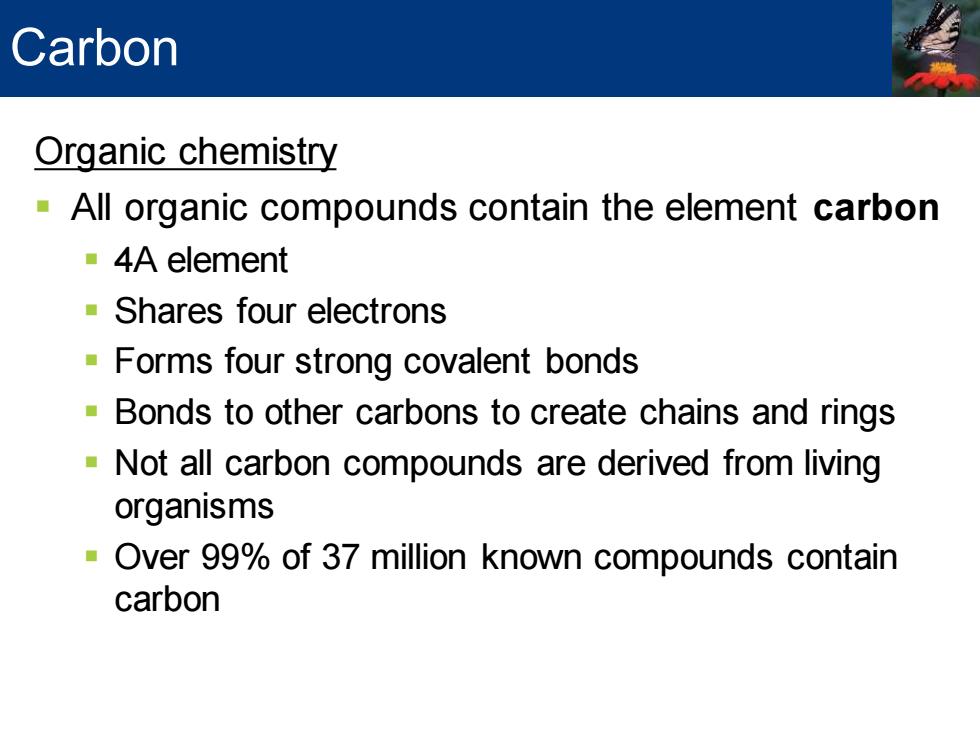
Carbon Organic chemistry -All organic compounds contain the element carbon 4A element Shares four electrons Forms four strong covalent bonds Bonds to other carbons to create chains and rings Not all carbon compounds are derived from living organisms -Over 99%of 37 million known compounds contain carbon
Organic chemistry ▪ All organic compounds contain the element carbon ▪ 4A element ▪ Shares four electrons ▪ Forms four strong covalent bonds ▪ Bonds to other carbons to create chains and rings ▪ Not all carbon compounds are derived from living organisms ▪ Over 99% of 37 million known compounds contain carbon Carbon
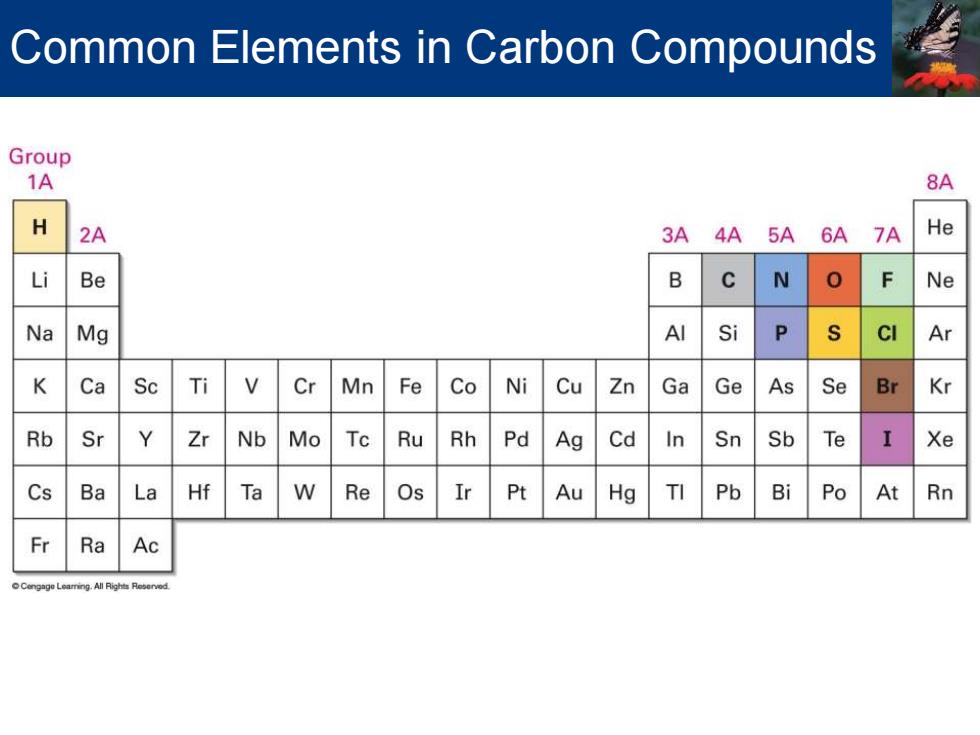
Common Elements in Carbon Compounds Group 1A 8A H 2A 3A 4A 5A 6A 7A He Li Be B N Ne Na Mg AI Si P CI Ar K Ca Sc Ti Cr Mn Fe Co Ni Cu Zn Ga Ge As Se Br Kr Rb Sr Y Zr Nb Mo Tc Ru Rh Pd Ag Cd In Sn Sb Te Xe Cs Ba La Hf Ta W Re Os Ir Pt Au Hg TI Pb Bi Po At Rn Fr Ra Ac
Common Elements in Carbon Compounds
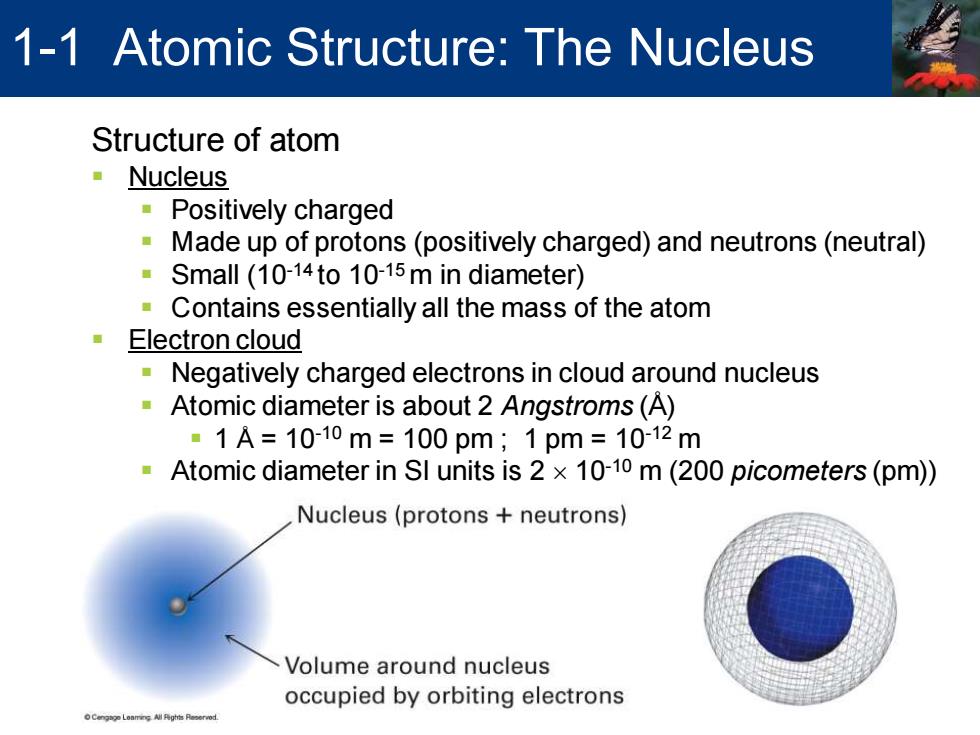
1-1 Atomic Structure:The Nucleus Structure of atom ·Nucleus ·Positively charged Made up of protons(positively charged)and neutrons(neutral) 意 Small (10-14to 10-15m in diameter) Contains essentially all the mass of the atom Electron cloud Negatively charged electrons in cloud around nucleus Atomic diameter is about 2 Angstroms(A) 。1A=1010m=100pm;1pm=1012m Atomic diameter in SI units is 2 x 10-10 m(200 picometers(pm)) Nucleus(protons neutrons) Volume around nucleus occupied by orbiting electrons
Structure of atom ▪ Nucleus ▪ Positively charged ▪ Made up of protons (positively charged) and neutrons (neutral) ▪ Small (10-14 to 10-15 m in diameter) ▪ Contains essentially all the mass of the atom ▪ Electron cloud ▪ Negatively charged electrons in cloud around nucleus ▪ Atomic diameter is about 2 Angstroms (Å) ▪ 1 Å = 10-10 m = 100 pm ; 1 pm = 10-12 m ▪ Atomic diameter in SI units is 2 10-10 m (200 picometers (pm)) 1-1 Atomic Structure: The Nucleus
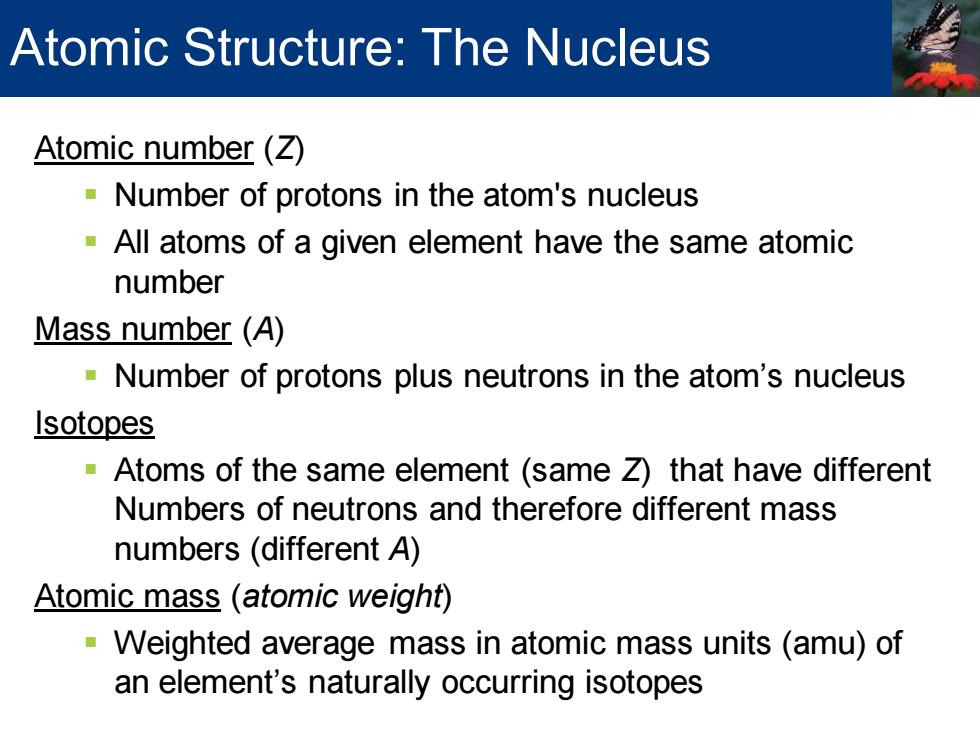
Atomic Structure:The Nucleus Atomic number (Z) Number of protons in the atom's nucleus All atoms of a given element have the same atomic number Mass number (A) Number of protons plus neutrons in the atom's nucleus Isotopes Atoms of the same element (same Z)that have different Numbers of neutrons and therefore different mass numbers(different A) Atomic mass (atomic weight) -Weighted average mass in atomic mass units (amu)of an element's naturally occurring isotopes
Atomic number (Z) ▪ Number of protons in the atom's nucleus ▪ All atoms of a given element have the same atomic number Mass number (A) ▪ Number of protons plus neutrons in the atom’s nucleus Isotopes ▪ Atoms of the same element (same Z) that have different Numbers of neutrons and therefore different mass numbers (different A) Atomic mass (atomic weight) ▪ Weighted average mass in atomic mass units (amu) of an element’s naturally occurring isotopes Atomic Structure: The Nucleus
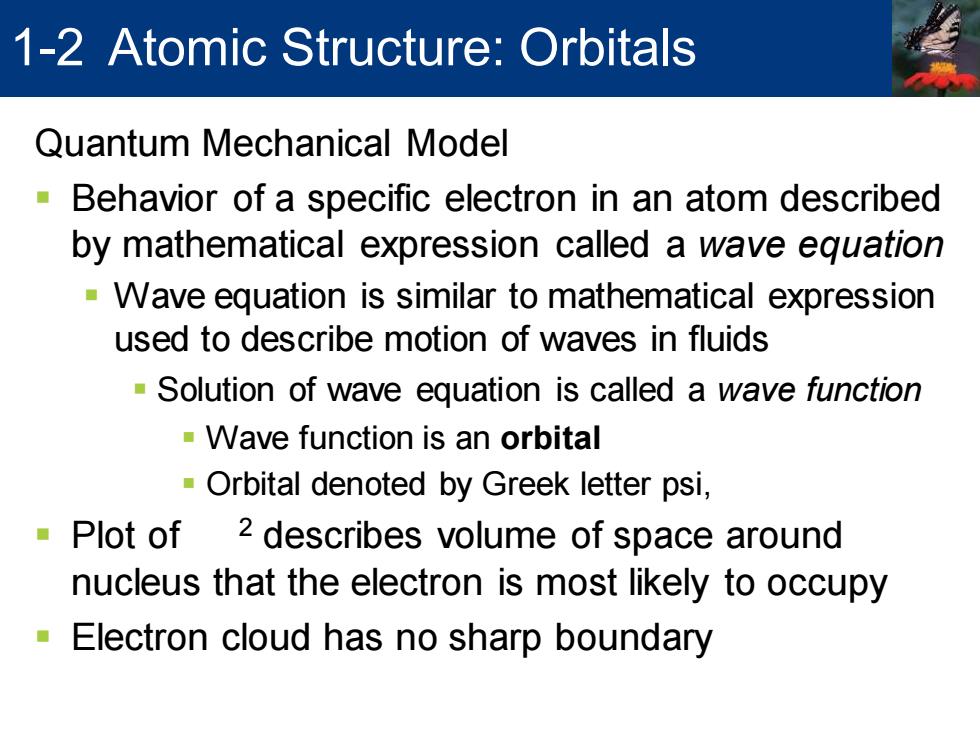
1-2 Atomic Structure:Orbitals Quantum Mechanical Model Behavior of a specific electron in an atom described by mathematical expression called a wave equation Wave equation is similar to mathematical expression used to describe motion of waves in fluids -Solution of wave equation is called a wave function -Wave function is an orbital Orbital denoted by Greek letter psi, Plot of 2 describes volume of space around nucleus that the electron is most likely to occupy Electron cloud has no sharp boundary
Quantum Mechanical Model ▪ Behavior of a specific electron in an atom described by mathematical expression called a wave equation ▪ Wave equation is similar to mathematical expression used to describe motion of waves in fluids ▪ Solution of wave equation is called a wave function ▪ Wave function is an orbital ▪ Orbital denoted by Greek letter psi, ▪ Plot of 2 describes volume of space around nucleus that the electron is most likely to occupy ▪ Electron cloud has no sharp boundary 1-2 Atomic Structure: Orbitals
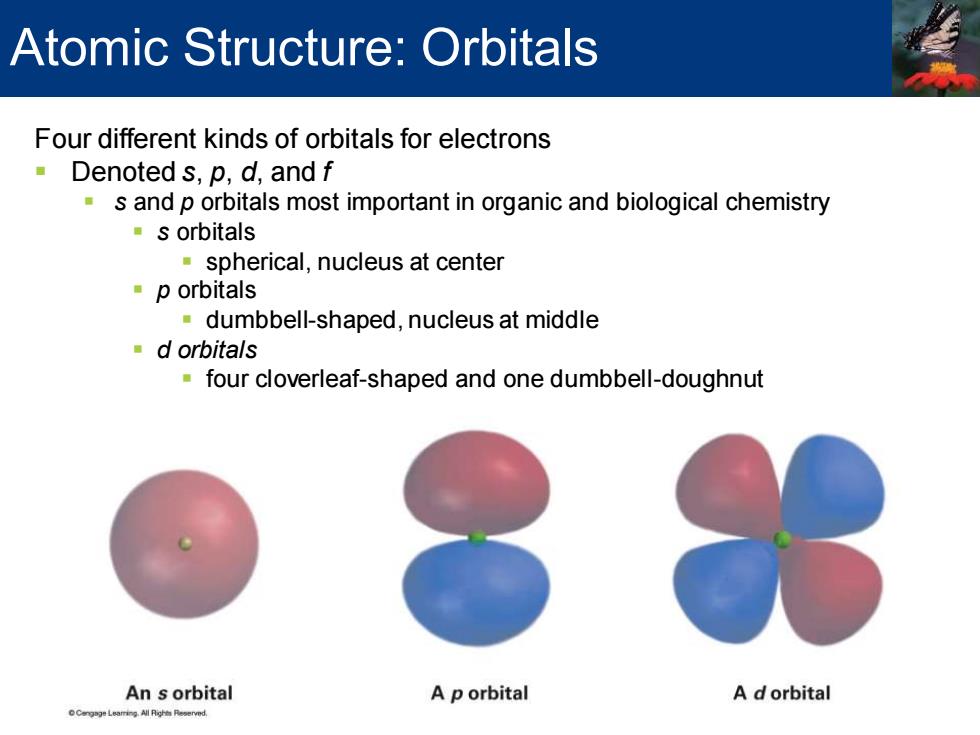
Atomic Structure:Orbitals Four different kinds of orbitals for electrons Denoted s,p,d,and f s and p orbitals most important in organic and biological chemistry s orbitals spherical,nucleus at center p orbitals dumbbell-shaped,nucleus at middle d orbitals four cloverleaf-shaped and one dumbbell-doughnut An s orbital A p orbital A dorbital
Four different kinds of orbitals for electrons ▪ Denoted s, p, d, and f ▪ s and p orbitals most important in organic and biological chemistry ▪ s orbitals ▪ spherical, nucleus at center ▪ p orbitals ▪ dumbbell-shaped, nucleus at middle ▪ d orbitals ▪ four cloverleaf-shaped and one dumbbell-doughnut Atomic Structure: Orbitals